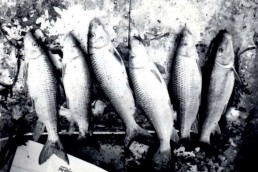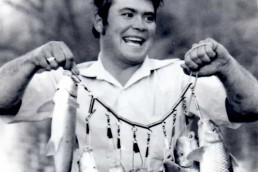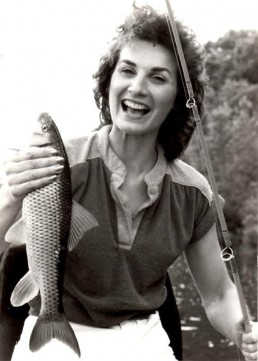The Oddball Redhorse is full of Surprises
SHARE THIS POST
Excitement welled up as the underwater camera monitor showed a 4-pound river redhorse sucker creeping up on the number 8 Flick Fly.
Would he take it, or pass it up?
I’d taken carp on this same fly—a yellow, wet fly pattern similar to a yellow sally. Oh, I’d cheated a bit by tipping the fly with a tiny anise-scented Red Ball egg. But would that be enough to entice the wary bottom- feeder? Two inches downstream from the fly’s flashing tail spinner, the fish stopped, held steady and eyed the prize.
Then, it must have been the scent.
She edged forward, as suckers do to engage food, and lifted her sucker-shaped mouth up and over the prize. Next came several organ-like movements of her snoot as the fly was ingested. I lifted the fly rod and was into my first sucker on a Flick Fly.
What came next surprised me. And if you’ve never had the chance to observe a redhorse sucker you’re in for a surprise.
Immediately upon being hooked, the redhorse dashed downstream with alarming speed and tenacity. I was nearly into my reel’s backing when she turned toward the center of the stream. Once turned, she came to the surface and cartwheeled out of the water. This leap was an unexpected pleasure. I’d caught a whitefish, a fish of similar looks, which have a tendency to leap when taken on a fly, but I was shaken and pleasantly surprised that a bottom-feeder like a sucker would have similar abilities.
Next, my fish nosed toward the main current in a 25-foot run. Then, as if resenting my intrusion, she hung deep, refusing to give way and used current pressure to fight me. I gradually managed to chase it to the boat and the landing net. Several times she rolled over, displaying skill that might detach her from the hook, a similar tactic used by channel catfish.
Finally, she was in my net as her circular snoot pulsated in an effort to allow her to catch her breath.
I have caught dozens of redhorse over the years, naming them “Minnesota Bonefish,” as they fell prey to nightcrawler-laced hooks. But this one was special—she was my first on an artificial fly.
Besides that, this fish seemed to be ablaze in color, as its back was emerald green, the fins blood red and sides glittering silver.
Yup. In my hands rested a Minnesota Bonefish.
The Upper Mississippi River above the twin cities is alive with redhorse. Their numbers may have decreased somewhat since channel catfish were first introduced 20 years ago. Even so, if you wish to engage this species, a gob of worms placed on the rocky-bottomed stretches of the river will always catch you a few if you have the patience to wait.
Are you enjoying this post?
You can be among the first to get the latest info on where to go, what to use and how to use it!
This day, “Bobber” Anne and I had been shooting underwater footage of smallmouths striking a new fly the company was about to introduce to the fishing public. Thus, it was a setting for my first encounter with redhorse suckers on a fly. And it wouldn’t be my last.
Suckers are found in 95 percent of our waters. In member of the Catastomidae family, they are found in only two other regions in the world, Siberia and areas of China. All host a jaw devoid of teeth, but do have combined numerous feathery appendages in their accordion-like mouths, which are used to separate food such as larvae from the mud they are found in. Most suckers are scaled and host a short, bony head with a round, muscular body loaded. Not considered a food fish by modern anglers, they are prized as food for Native Americans when smoked.
As a boy growing up in the wilds of northern Ontario, this fish was considered as sleigh dog food. To best utilize suckers for our family dog team we would cook them in chunks in a base of oatmeal. Cooked in a 55-gallon drum over an open fire, after freeze-up, the concoction of one-third sucker parts to two-thirds oatmeal would be left to freeze solid. Once frozen, this healthy food would be cut up and chunked up then fed in frozen pieces to the dogs.
Although suckers have an extreme number of featherbones that cannot be removed when cleaning, my mother had a way of preparing the rich white meat. Filleted like a walleye, these would then be run through a meat grinder after having their bones cut in close with slicing made every 1/4 inch or so. Cutting was done from the inside (stomach side) of the fillet, but never completely through the piece of meat, just enough to cut up the featherbones.
Once run through the grinder, Mother would make fish patties out of the ground up fish. When fried, like you’d do to any other fish, they were delicious and highly prized during the long winter days of the North.
With ice on our lake nearing 6 feet, ice angling was never part of our winter outdoor activities. Keep in mind we only had ice chisels and axes to cut the hole, didn’t have any ice augers at that time.
I can only tell my readers how good those frozen sucker patties were when Mother cooked them on a Friday night in January and February. Which suckers did we use? Redhorse were preferred, while the brown and white suckers went to the dogs.
Intrigued by my catch of the hard-fighting redhorse, “Bobber” Anne had decided to give it a try. When it comes to taking up something new in the fishing world, as always, she caught on right away.
That brings me to a final suggestion: Why don’t you give it a try?
Laugh off the negative response you’ll get from your bass pro friend. Let him stick to catching those lazy one-jumpers and give sucker fishing a try. It’s fun, and they fight ten times better than a bass.
All you need is a fly rod and reel, a fly (our Flick Fly if you can find one) and something to scent that fly. The tail spinner of the Flick Fly is the teaser while a bit of scent enhances the sucker’s strike. A slow retrieve near the bottom of your local river will serve as a fishery.
Considered one of the world’s leading river anglers, Dan Gapen, Sr. will continue to recount his past and recent adventures and offer up his knowledge to MidWest Outdoors readers. For more information call The Gapen Company at 763-263-3558, email them at gapen@gapen.com or visit them at Facebook @TheGapenCompany.
MWO
SHARE THIS POST
You may also like...
Nothing found.
Did you enjoy this post?
You can be among the first to get the latest info on where to go, what to use and how to use it!
MWO
We believe being outdoors is good. With more than 1,000 articles each year, MidWest Outdoors magazine is all about sharing outdoor experiences with you—where to go, what to use and how to use it… whether you’re close to home or on that trip of a lifetime.


